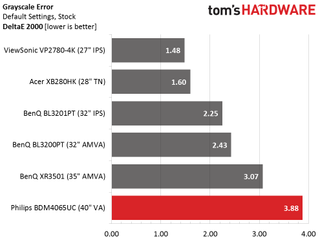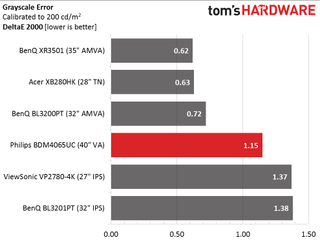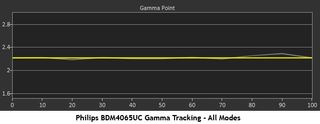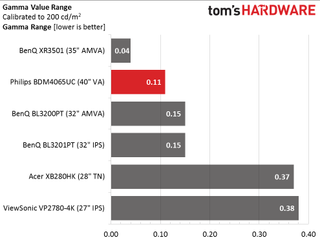Philips BDM4065UC 40-inch Ultra HD Monitor Review
Why would you put the Philips BDM4065UC on your desk? Because it's 40 inches with Ultra HD resolution and a 5000:1 contrast ratio. Today we check it out in our lab.
Why you can trust Tom's Hardware
Grayscale Tracking And Gamma Response
Our grayscale and gamma tests are described in detail here.

The BDM4065UC offers three picture modes. Color Temperature is the default and shows an obvious but not extreme blue tint. You can adjust it in degrees Kelvin but the stops are quite far apart. One click warmer means 5000K which is much too red. Let’s see what happens in the sRGB preset.

sRGB only improves tracking by a marginal amount. The average error goes from 3.88 to 3.19 Delta E. You can still see the blue tint and the brightness control is locked out. The only advantage to this mode is better color gamut accuracy which we’ll talk about on the next page.

The User mode offers a decent grayscale calibration if you have the instruments available. Simply switching to that mode without further adjustment results in an error of 13.98dE which is very blue. The color temp is over 13,000K in fact. Dialing down the blue and green sliders brings things in line nicely. There is a small spike at 20 percent brightness but it’s not enough to be visible.
Here is our comparison group.

The BDM4065UC is a little weak out of the box and lags behind the rest of the monitors here. Of our jumbo screens, the BL3201PT ranks the best without calibration. If you don’t have the equipment, try our settings on page three and you’ll get pretty close to the same result.

Calibration improves grayscale tracking to a perfectly acceptable 1.15dE average error. There are still a few color gamut issues we’ll talk about on the next page but overall accuracy is more than adequate for gaming or productivity tasks.
Gamma Response

Even though there are five gamma presets, 2.2 is the only one you’re likely to need. As you can see it tracks almost perfectly regardless of the color mode. There is nothing to complain about here.
Here is our comparison group again.

The BDM4065UC just misses the top spot in this test. We can’t help but notice the top three panels are all VA. Good gamma tracking is key to making the most of high contrast. It seems that VA has checked that box.
We calculate gamma deviation by simply expressing the difference from 2.2 as a percentage.

The Philips and BenQ screens score a perfect zero percent in this test by virtue of their 2.2 average gamma values. It can’t get any better.
Current page: Grayscale Tracking And Gamma Response
Prev Page Brightness And Contrast Next Page Color Gamut And PerformanceStay on the Cutting Edge
Join the experts who read Tom's Hardware for the inside track on enthusiast PC tech news — and have for over 25 years. We'll send breaking news and in-depth reviews of CPUs, GPUs, AI, maker hardware and more straight to your inbox.

Christian Eberle is a Contributing Editor for Tom's Hardware US. He's a veteran reviewer of A/V equipment, specializing in monitors. Christian began his obsession with tech when he built his first PC in 1991, a 286 running DOS 3.0 at a blazing 12MHz. In 2006, he undertook training from the Imaging Science Foundation in video calibration and testing and thus started a passion for precise imaging that persists to this day. He is also a professional musician with a degree from the New England Conservatory as a classical bassoonist which he used to good effect as a performer with the West Point Army Band from 1987 to 2013. He enjoys watching movies and listening to high-end audio in his custom-built home theater and can be seen riding trails near his home on a race-ready ICE VTX recumbent trike. Christian enjoys the endless summer in Florida where he lives with his wife and Chihuahua and plays with orchestras around the state.
-
Oleander Bought one back in january. Best decision ever!Reply
A lot of bad stuff were said about it in forums (for all the wrong reasons) so it's nice to see that for what I use it (non first-person gaming and all-round) this review vindicates it.
Only remaining issue is the flicker of the backlight if brightness is not at 100%, but since the brightness is so low, it's not a problem to me. -
cats_Paw For professional use, absolutely.Reply
For gaming, probably not (Black levels are amazing for LED panel, and also contrast is amazing, but color delta and input lag... no way).
Plasmas are still king for gaming in my books, too abd they are almost all gone by now. -
Maryland_USA A completely unique product? I don't think so. Several other 40-inch monitors are available that will drive a VA panel at 3840x2160@60Hz through both DisplayPort 1.4 and HDMI 2.0. They're sold by AMH, Crossover, Iiyama, MIcroboard, and Seiki. Step up to 43 inches, and you must add Wasabi Mango. All but the Seiki and Iiyama cost less than the Philips.Reply -
Larry Litmanen I currently game on a 32 inch TV, honestly you can not go back to a monitor with a better resolution that is 24 or 27 inches. Once you go big it is just amazing.Reply
It's not just the width, you also need that vertical screen real estate.
-
hotdogee "Nearly every LCD panel on the planet is made by either Samsung, LG or AU Optronics. A few are also made by Innolux (formerly Chi Mei). But the Philips BDM4065UC is made by TP Vision, which is the actual owner of the Philips brand."Reply
The panel is made by Innolux for TP Vision. -
Eggz Great to see this. Is tom's planning on reviewing the new LG 4K OLED displays? They would seem to score very well in just about every category that matters for professional use. I'd love to see it, and the reviewers would also probably enjoy playing with one. Consider it, please.Reply -
Xorak I used a 32" 1080p TV for a long time, so I completely get the appeal of a big screen with great contrast and vibrant color, even if it's not the fastest or most accurate. Now I'm used to my MG279Q and would not go back to a fixed refresh screen. I hoped that 4096x2160 would start catching on too, but it looks like it won't. In the next 2 years a single GPU should be able to make use of a true 4k panel with variable refresh up to 75 or 90hz and it would be a thing of beauty at 30+ inches.Reply -
enewmen Can someone explain why not to use Ultra HD LEDs TV for computer work? (another dumb post) For small font text (using 1080p TVs) , the TVs did'n't look as sharp as PC monitors. But I don't see that as a problem for 2160p TVs. Yes, the TV must have HDMI 2.0 and the graphics card must also support that. But is that the only reason? Anyway, the Philips looks like an UHD TV made for PC work at a price similar to TVs.Reply
I also personally don't like Display Port cables because only the BEST cables won't give problems with recovering from sleep mode. Gave up on Display Port and currently using DVI Dual Link at 1440p. -
mavikt ReplyGreat to see this. Is tom's planning on reviewing the new LG 4K OLED displays? They would seem to score very well in just about every category that matters for professional use. I'd love to see it, and the reviewers would also probably enjoy playing with one. Consider it, please.
I too would like to see a proper technical review of said (TV) tech.
In a home theater magazine I subscribe to they said that the latency was around 50ms (55EG960V), didn't say how it was measured though. Otherwise they said it was The Perfect TV.
So it remains to be seen if LCD will "remain the dominant tech for the foreseeable future"
